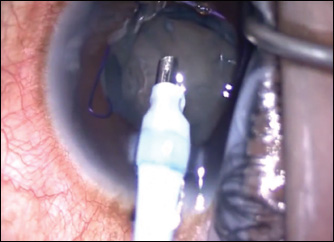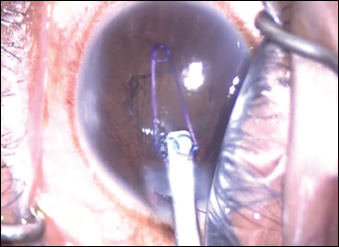Careful planning needed in cataract cases with inflammation
Patient with sarcoidosis and chronic anterior uveitis enjoyed restored vision after uneventful surgery.
Inflammation is a dreaded obstacle and potential complication of surgical procedures in general and can be sight-threatening in procedures such as cataract surgery. With regard to cataract surgery, even with modern-day technological advances and improved surgical procedures, inflammation is still a potential complication that needs to be addressed. Such ocular inflammation can be divided into three phases, preoperative, intraoperative and postoperative, and the surgeon needs to address all three periods to provide a comprehensive, optimal outcome. Additionally, potential intraoperative and postoperative complications should be routinely discussed with high-risk patients.
Preoperatively, any systemic diseases that can contribute to augmented postoperative inflammation may need to be treated with potent, systemic anti-inflammatory agents, and the surgeon may seek the assistance of a rheumatologist or other specialist to assist in this phase of treatment. In such high-risk cases, in addition to the use of topical NSAIDs and corticosteroid drops preoperatively, systemic corticosteroids may be needed. Additionally, one has to wait for an extended quiescent period with no ongoing active intraocular inflammation before cataract surgery is performed. Any surgical intervention during a period of ongoing active inflammation can result in an escalated inflammatory response and possible poor surgical result, including vision loss.
Intraoperatively, gentle tissue handling is a must in these cases, with minimal surgical intraocular manipulations during cataract surgery. Surgical tissue trauma contributes to the breakdown of the blood-aqueous barrier, leading to the release of inflammatory mediators, including prostaglandins and leukotrienes, and immune cascade activation. Use of capsular stains, pupil size-optimizing devices and ophthalmic viscosurgical devices may be used as needed to increase visualization and decrease possible complications.
Postoperatively, ocular inflammation contributes to anterior chamber cell and flare, redness, photophobia, pain and discomfort, increased IOP, miosis, fibroblast proliferation, scar formation, synechiae formation, pseudophakic cellular adhesions, cystoid macular edema and decreased vision. Hence, the surgeon should address all three phases of cataract surgery with a focus on decreasing inflammation associated with cataract surgery.
In this column, Dr. Irshad describes his approach to cataract surgery in a patient with sarcoidosis and chronic anterior uveitis.
Thomas “TJ” John, MD
OSN Surgical Maneuvers Editor

I recently performed cataract surgery on a 36-year-old man with a history of sarcoidosis and chronic anterior uveitis. When this patient was first referred for uveitis, we worked with his primary care doctor to establish a relationship with a rheumatologist and get the underlying systemic disease under control and, finally, resolve the uveitis-related inflammation with topical corticosteroid drops. During that period, cataract surgery was postponed until absolutely necessary, but the patient was now presenting with advanced — nearly white — bilateral cataracts that limited his vision to about 20/200 in each eye.
I decided to proceed with cataract surgery. I started the patient on oral steroids beginning 2 weeks before surgery and continuing through the perioperative period. The second eye was operated on 2 weeks after the first, and the patient tapered off the oral steroids. Sub-Tenon’s triamcinolone was also given at the conclusion of surgery and helped prevent a recurrence of uveitis postoperatively.
Single-piece aspheric hydrophobic acrylic IOLs were implanted in both eyes, and the patient now sees 20/30 uncorrected. IOP was elevated postoperatively (in the mid-20s) but is now well-controlled on glaucoma drops.

Source: Farhan A. Irshad, MD





I like to use this case to illustrate to residents that by paying attention to the fundamentals of cataract surgery and preparing for known challenges, one can achieve an excellent outcome even in a complicated case.
Mitigating risks
First of all, I wanted to avoid rebound inflammation, which can lead to scarring, posterior synechiae, macular edema and significant early posterior capsular opacification. Any combination of these could leave this young patient with permanent vision loss, so I was careful to ensure that there had been no flareups of inflammation for several months before surgery and then treated aggressively with steroids through multiple methods of administration during the perioperative period.
This patient had miotic pupils that would not dilate well. I needed to expand the pupil but also wanted to avoid excessive manipulation that could increase the potential for an inflammatory response. There are several options for pupil expansion, but in this case I used a Malyugin ring (MST), which I find to be gentle on the iris and able to preserve a more round-shaped pupil postoperatively. The small pupil and advanced cataract also made visualization of the capsule difficult. I stained the capsule with trypan blue (VisionBlue, Dutch Ophthalmic) to enhance visualization and help me achieve a continuous and complete capsulorrhexis.






Patience and flexibility are important to avoid tearing the fibrotic capsule. If the capsulorrhexis is not tearing easily in one direction, the surgeon can go in the other direction or convert to a can opener-style capsulotomy. I also like to keep the capsulorrhexis small, less than 5 mm, and reinject viscoelastic as needed to keep the anterior chamber deep and with sufficient pressure to protect against a radial capsular tear.
I prefer a venturi pump over a peristaltic for efficient removal of the cataract. In this case, I used the Bausch + Lomb Stellaris phaco machine with no changes to my normal settings and bottle height. It is critical to ensure complete removal of all nuclear and cortical material and a clean capsule at the end of the case.
I implanted ZCB00 Tecnis monofocal IOLs (Johnson & Johnson Vision) in both eyes. Had there been an issue with the capsulorrhexis or a tear in the posterior capsule, I was prepared to put in a three-piece lens, but I prefer the ZCB00 for its easy centration and nicely controlled, low-manipulation unfolding. I also find that the aspheric optics of this lens provide patients with superior quality of vision compared with other monofocal IOLs, so I was pleased to be able to use it in this case.
Finally, close postoperative monitoring is needed in inflammation-prone eyes. I saw this patient for an extra visit in the first week (day 1, day 3 and week 1), and we also scheduled a retina consult before cataract surgery to make sure the retina was flat, with a good prognosis for full visual recovery.
This case ultimately went smoothly, but there were many uncertainties at the outset. Preparation and patience throughout the case led to an excellent outcome and a satisfied patient.
Editor’s note: Please see accompanying video at https://www.healio.com/ophthalmology/cataract-surgery/news/online/%7B7a6d1a66-bae0-494e-bca9-44a9f52569fd%7D/video-white-cataract-in-sarcoidosis-patient-with-chronic-uveitis.
- For more information:
- Farhan A. Irshad, MD, is an assistant clinical professor of ophthalmology at Tulane Medical Center and in private practice at Eye Clinic of Austin, Texas. He can be reached at email: firshad@tulane.edu.
- Edited by Thomas “TJ” John, MD, a clinical associate professor at Loyola University at Chicago and in private practice in Oak Brook, Tinley Park and Oak Lawn, Ill. He can be reached at email: tjcornea@gmail.com.
Disclosures: Irshad reports he is a KOL for Bausch + Lomb. John reports no relevant financial disclosures.
